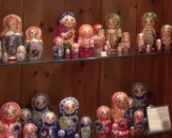Babushkas Story
No Description
When you think of Melbourne, many things come to mind: smashed avocados, painfully hip coffee shops and boutiques, its lane-ways and hidden shops. However, Russian matryoshka dolls are probably not one of them.
Yet, tucked away in Australia’s oldest shopping arcade, a beautifully decorated shop has made its living for twenty-five years selling precisely that.
Babushkas has long been a part of Melbourne’s Royal Arcade, and the intricate, hand-crafted matryoshka dolls, marionettes, chess sets, and amber jewellery are imported from all over Eastern Europe, including Russia, Poland, Sovakia, and the Czech Republic.
Mr Richard Seager, the owner of Babushkas, told us how he got started. “I went to Poland in 1990, back when it was still a Communist country. You needed an invitation to get in then, but I had a friend in Poland, so I didn’t have much trouble there.”
Mr Seager, a Russian history enthusiast, began collecting items from the markets of Warsaw and bringing them back to Australia. Eventually he opened a tiny shop in the Royal Arcade in December 1991, before moving to its current premises a mere five months later.
“It’s surprising, you get all sorts in here. There’s a few Russians and Eastern Europeans, but that’s not our main market. The main market is just a combination of a typical Melbournite [sic] and tourists who are coming past the door.”
“People seem to have a fascination with them, and they buy the dolls as gifts, or as decorations. Sometimes people buy the novelty ones, we’ve run out of the Beatles, but the traditional ones sell really well too,” he said.
The Dolls Origins
The dolls themselves are quintessentially Russian, but their origin may surprise you. Sergey Malyutin, a folk arts painter, and Vasily Zvyozdochkin, a doll maker, made the first Russian nesting doll after being inspired by a doll from Honshu, the main island of Japan.
The dolls were originally designed after traditional stories and fairy tales, but have since expanded to include new themes, including religion and pop culture. Babushkas had a set of political matryoshkas on their shelf, with political figures such as Barack Obama and Vladimir Putin painted on them.
“The largest doll is usually the current prime minister or president, and the smaller dolls will be his predecessors, depending on the artist,” Seager said.
The Troubles
This shop is now in danger of closing down.
The Russian nesting doll business might not have many competitors, but one would be forgiven for being sceptical about the market size for matryoshka dolls. A July 2017 census of Melbourne showed just 6,307 Russians living in Victoria, a state that has almost six million people living within its borders.
“It’s not a huge market, but it’s been quite adequate for this store,” Seager said. As it turns out, the difficulty of Babushkas’ current situation was entirely unrelated to consumer demand.
“It’s probably got more to do with our inability to invest in inventory. Over the last three years, we’ve had a few problems with an accountant back in 2014, and that has sort of divested us from the capital that we had,” he said.
“We’ve had to narrow down our offerings, we used to have a much greater variety. Our inventory used to be twenty times this, now what you see on the shelves is all we have.”
Mr Seager and his wife used to make glass ornaments for Christmas and Easter in the workshop above Babushkas. “I think this year we’re going to focus on the dolls,” he laughed.
The Future
When asked what he would do if Babushkas had to shutter its doors, Richard Seager looked pensive. “I don’t know that I’d start selling dolls again, but I would definitely like to get back into retail.”


[…] liked this blog post about a quirky shop in the Royal Arcade, though I fear the shop may have closed its doors since the […]